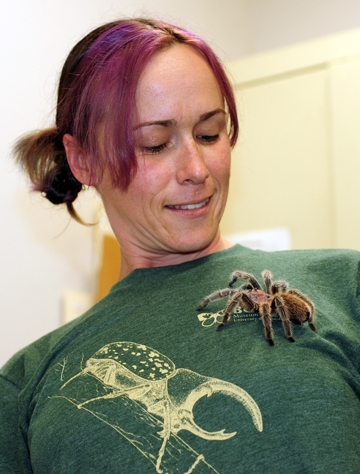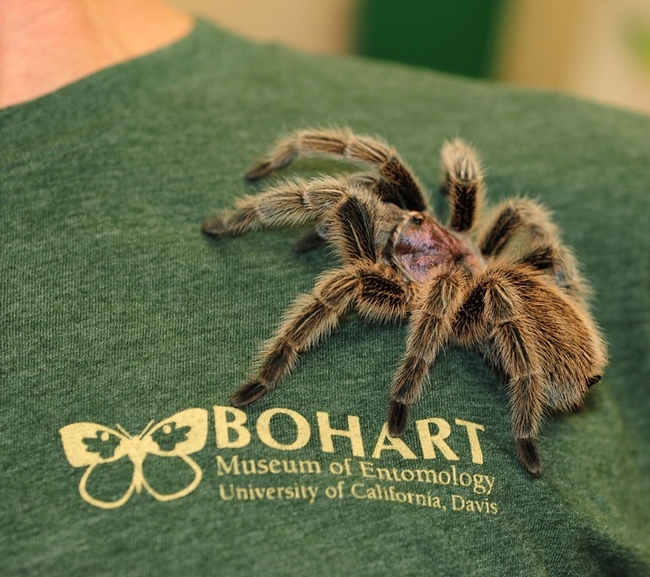
Rosie, the popular 24-year-old Chilean rose-haired tarantula at the Bohart Museum of Entomology, University of California, Davis, is approaching the end of her natural life span.
So when a UC Davis student donated the same species, a four-year-old taranatula (Grammostola rosea), to the museum in late January, Bohart officials launched a contest: “Name the tarantula.”
Meet “Peaches.”
The name won out over Cuddles, Matilda, Bambi, Bobbie, Charlotte, Fluffy, Harriet, Maria, Pinkie, Rush, Tammy, Tessie, Twinkie, Lucy and Mandy, as well as Chili (Chilean rose-haired tarantula), Pepper (Chili pepper) and Gramma (Grammostola rosea).
The arachnid, native to Chile and also common in Bolivia and Argentina, is a favorite of the exotic pet trade market and is sold in many American and European pet stores
“It's good to have a name like Peaches,” said Lynn Kimsey, director of the Bohart Museum and professor of entomology at UC Davis. “If you name it something like Fang, some of our Bohart Museum visitors would be afraid to hold it. We need to get people past the fear so they're not terrified.”
Tarantulas are generally harmless to humans, even though they do produce a venom to kill their insect prey.
Peaches, who is held every day, is a beautiful tarantula and quite docile, Kimsey said. Her counterpart, Rosie, was a popular attraction at open houses and at the annual UC Davis Picnic Day, where as many as 400 held her in one day. Visitors delighted in capturing images of her.
But now, Rosie is quite frail, Kimsey said, and quite old. Female tarantulas can live some 30 years.
Peaches is now part of the educational exhibit at the Bohart, where personnel will explain why a tarantula is not an insect, but a part of the spider family. It has two main parts, the prosoma (or cephalothorax) and the opisthosoma (or abdomen). A waist-like pedicle connects the two. They have small spinelike urticating hairs on their abdomen that they may release when threatened.
Peaches' menu includes crickets and mealworms. Rose-haired tarantulas also dine on grasshoppers, moths, beetles and cockroaches. Larger tarantulas catch larger prey, including mice and frogs.
Other special attractions at the Bohart Museum's live “petting zoo” include Madagascar hissing cockroaches and walking sticks.
The museum, located in Room 1124 of the Academic Surge Building on Crocker Lane, houses a global collection of nearly eight million specimens. It is also the home of the seventh largest insect collection in North America, and the California Insect Survey, a storehouse of the insect biodiversity. Noted entomologist Richard M. Bohart (1913-2007) founded the museum.

The Bohart Museum is open to the public from 9 a.m. to noon and 1 to 5 p.m. Mondays through Thursdays. The museum is closed to the public on Fridays and on major holidays. Admission is free. Open houses, focusing on specific themes, are held on weekends throughout the academic year. Admission is free.
The Bohart Museum will be one of six museums open on the UC Davis Fourth Annual Biodiversity Museum Day, to take place Sunday, Feb. 8 from 12 noon to 4 p.m.. Other collections open will be at the Center for Plant Diversity, the Botanical Conservatory, the Paleontology Collection, the Anthropology Collection, and the Museum of Wildlife and Fish Biology.
The remainder of the Bohart Museum's open houses:
- Sunday, Feb. 8: “Biodiversity Museum Day,” noon to 4 p.m.
- Saturday, March 14: “Pollination Nation,” 1 to 4 p.m.
- Saturday, April 18: UC Davis Picnic Day, 10 a.m. to 3 p.m.
- Sunday, May 17: “Name That Bug! How About Bob?” 1 to 4 p.m.
- Saturday, July 18: “Moth Night,” 8 to 11 p.m.
For more information, contact the Bohart Museum at (530) 752-0493 or emailing bmuseum@ucdavis.edu.
Attached Images:
